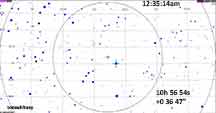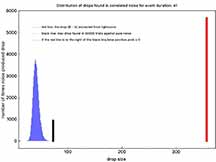

This event is favorable in all ways except - it's got a low rank. It's a bright star, with a complete drop of 6 magnitudes. Santa Cruz is decently inside the 1-sigma range. However the odds on the centerline are only 30%, and are 21% for downtown Santa Cruz. The duration is only 1.4 seconds, so we should cut integration to a minimum of 2x setting, or if clouds allow, even 1x and then use LiMovie for reductions. The altitude is 53 degrees at Az 165 in the west, in southern Leo/Sextans border. The target is conveniently close to a 6.0 magnitude star which provides the coordinates we should set scope to, in the charts below.
The low rank doesn't justify travelling to. We should just try it from home and save sleep.
 |
 |
We got lucky! Only 21% odds of a positive, but both Kirk and I got solid positives. Karl had a miss, as I would expect if Kirk and I got positives. My IOTA report sent in on 2/23/23.
Nolthenius Data (PyOTE log file)
I observed from my driveway, through skies that had cleared. The 11.0 star was so bright and the interval of 1.4 seconds so brief, that I decided to try to do it in field mode and get 1/60s time resolution. However, the star wasn't really quite bright enough to make this really improve time precision. I should have gone with 2x setting. I tried reducing it in LiMovie, but LiMovie did not read the video's time stamps for some reason. So, I re-reduced in PyMovie and left it in frame mode. That meant the star would be only half as bright as if I'd just gone with 2x to begin with, unfortunately. However, the occultation was still quite sharp and timing accuracy was excellent
First pix are from the LiMovie analysis.
|
The LiMovie screen. |
The occultation drop. Time stamps were missing, but otherwise the data look very good. |
LiMovie for some strange reason, did not pick up the time stamps. Perhaps a re-do would help, but the data quality visible above suggests that it would not improve the timings accuracies, so I decided to re-analyze using PyMovie.
|
PyMovie screen capture |
The tracking star used is similar in brightness as the target, no saturated pixels. I used "snap to" dynamic aperture |
The sky light curve |
The occultation happened ~perfectly on time. but with a north shift into Santa Cruz. |
And PyOTE solution
|
False Positive test passed easily |
The PyOTE solution. Very good timing accuracies; 2-sigma confidence interval is .02 sec. |
 |
Occultation lasted 1.2679s for me
Kirk's data show a 1.3442 second occultation with excellent data quality for this fairly bright star. Kirk used 2x, analyzing in frame mode.
 |
Target in yellow. |
PyMovie target |
 |
Excellent timing accuracy of .01s at 2-sigma level |
magDrop report: percent Drop: 97.2 magDrop: 3.863 +/- 0.800 (0.95 ci)